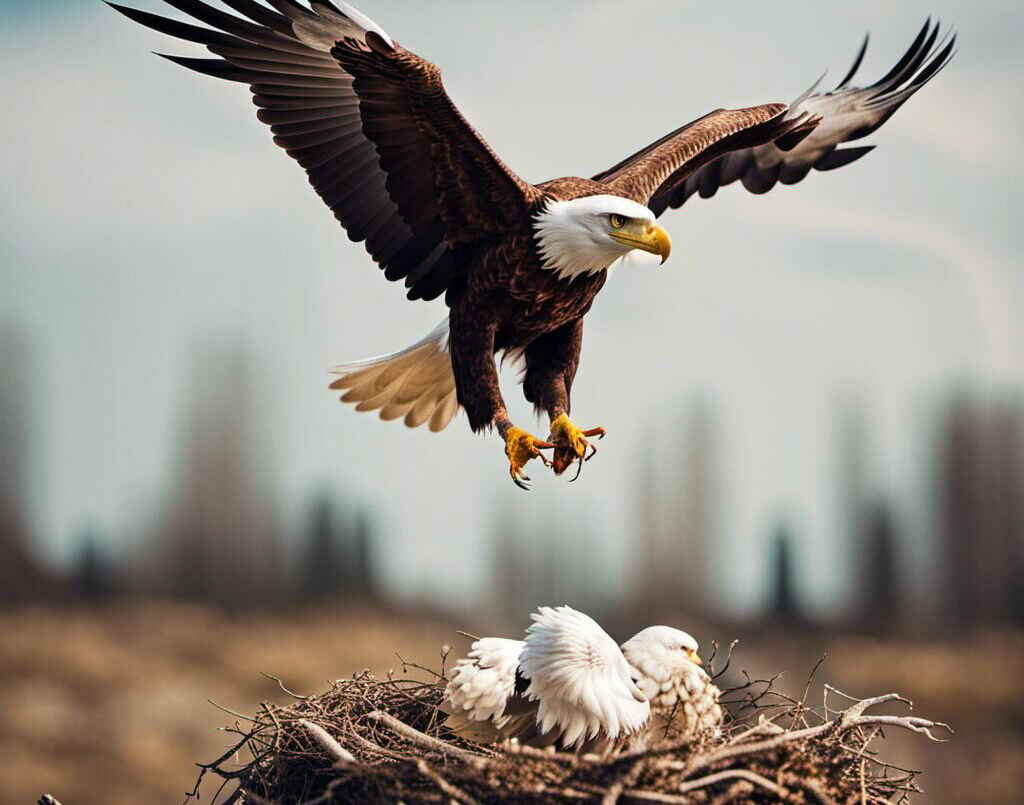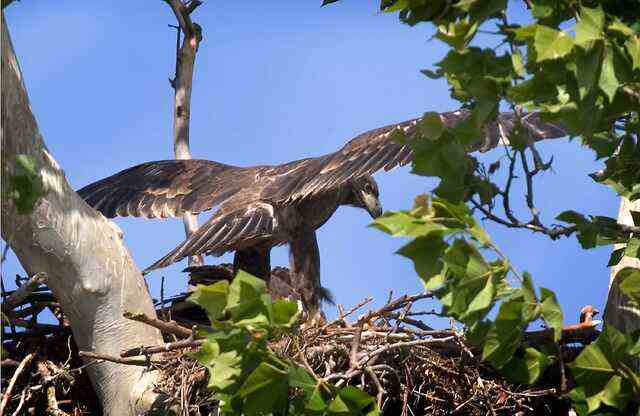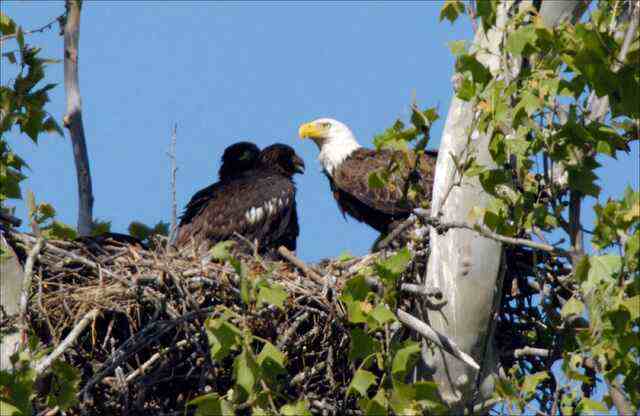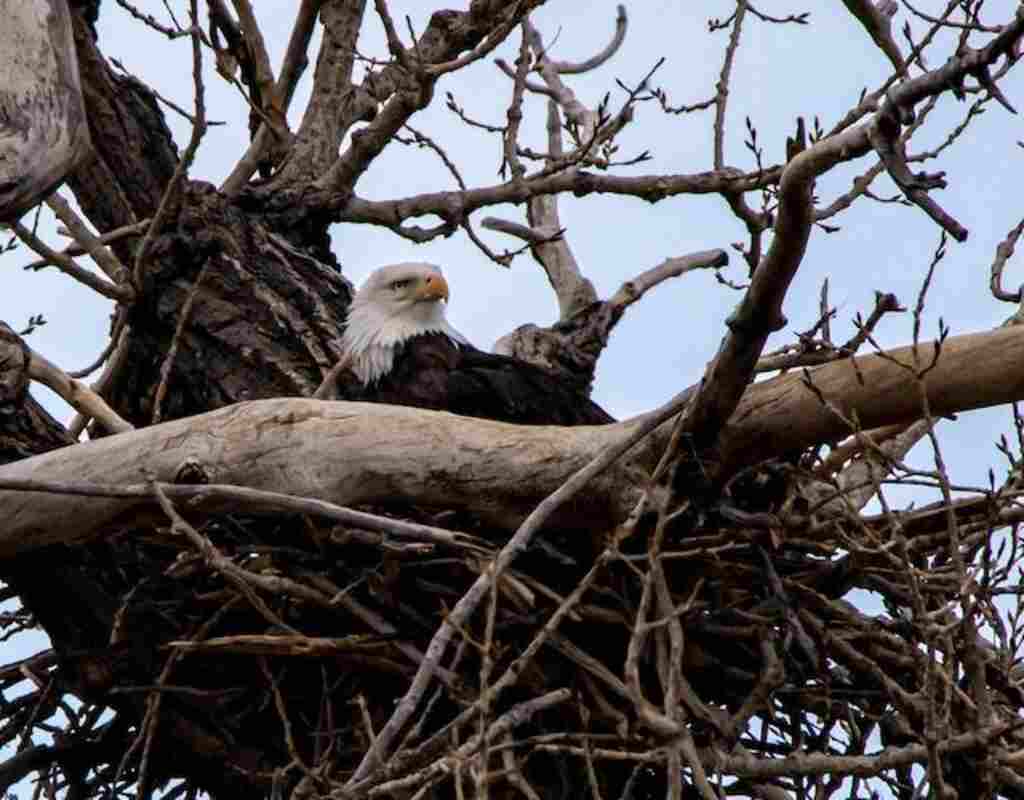In the vast expanse of Indiana’s natural landscapes, a captivating spectacle unfolds every year when majestic eagles engage in courtship rituals and begin mating.
Against the backdrop of sprawling forests and winding rivers, these iconic birds of prey grace the skies with powerful wings and piercing gaze.
Understanding “When Do Eagles Mate In Indiana?” is crucial for wildlife enthusiasts and conservationists.
This article delves into the intricacies of the breeding season, shedding light on the courtship rituals, nesting habits, and habitat selection of eagles. Witness this remarkable display of nature’s wonders in Indiana.
Table of Contents
- 1 Key Takeaways
- 2 When Do Eagles Mate In Indiana
- 3 The Breeding Season of Eagles in Indiana
- 4 Courtship Rituals of Eagles
- 5 Nesting Habits and Habitat Selection
- 6 The Egg-Laying Process
- 7 Hatching and Raising Eaglets
- 8 Challenges and Threats During the Breeding Season
- 9 Migration Patterns of Eagles in Indiana
- 10 Conservation Efforts and Protection of Eagle Populations
- 11 The Significance of Eagle Mating in the Ecosystem
- 12 Best Places to Observe Eagle Mating in Indiana
- 13 Some Common about Eagle Mating in Indiana
- 14 Conclusion
- 15 Frequently Asked Questions
- 15.1 How long does the mating process of eagles in Indiana typically last?
- 15.2 Are there any specific behaviors or vocalizations that eagles use to attract a mate?
- 15.3 Do eagles in Indiana mate for life, or do they find new partners each breeding season?
- 15.4 Are there any specific environmental factors that influence the timing of eagle mating in Indiana?
- 15.5 Do eagles in Indiana perform any elaborate courtship displays or rituals before mating?
- 16 Author
Key Takeaways
- Eagle mating in Indiana occurs from January to March.
- Male eagles establish territories and engage in courtship displays, including aerial acrobatics and mutual preening.
- Female eagles lay one to three eggs, which are incubated for about 35 days.
- Eagles build nests in tall trees near bodies of water and fiercely defend their nesting sites.
When Do Eagles Mate In Indiana
Eagles typically mate in Indiana from January to March, with nesting activity starting one to three months before the female lays eggs. However, the exact timing can vary depending on the location and weather conditions.
Eagles tend to mate for life, and if one partner dies, the other quickly finds a new mate if one is available. If you’re interested in viewing eagles during mating season, it’s important to observe them from a safe distance to avoid disturbing their natural behavior.
The Breeding Season of Eagles in Indiana
The breeding season of eagles in Indiana typically occurs during the winter months, specifically from January to March. During this time, eagles engage in various breeding behaviors to ensure reproductive success.
Male eagles establish territories and engage in courtship displays to attract females. These displays often involve aerial acrobatics, such as high-speed chases and impressive dives.
Once a pair is formed, they engage in elaborate courtship rituals, including mutual preening and sky-dancing displays, where they lock talons and spiral through the air.
These rituals strengthen the bond between the pair and ensure successful mating.
Following successful courtship, the female eagle will lay one to three eggs, which are incubated by both parents for about 35 days.
The breeding season of eagles in Indiana is a critical time for their population growth and survival, and understanding their behavior is crucial for conservation efforts.
Courtship Rituals of Eagles
Courtship rituals of eagles in Indiana typically occur during the winter months, with a fascinating statistic indicating that the male eagle will perform an intricate aerial display to attract a female partner.
These courtship behaviors involve the male eagle flying high in the sky and executing a series of acrobatic maneuvers, such as spirals, dives, and loops, while emitting loud calls.
This display not only showcases the male’s physical prowess but also serves as a demonstration of his ability to provide for a potential mate and offspring.
The female eagle closely observes these courtship displays, assessing the male’s fitness and evaluating his suitability as a partner.
Once the male successfully attracts a female through his courtship display, the pair will proceed to the next stage of their reproductive cycle, which involves nesting habits and habitat selection.
Nesting Habits and Habitat Selection
Nesting habits and habitat selection are crucial factors in the reproductive cycle of eagles in Indiana. Eagles typically build their nests in tall trees near bodies of water, providing them with a clear view of their surroundings and easy access to food sources.
They construct their nests using sticks and twigs, lining the interior with softer materials such as grass and moss. The size of the nest can vary, with older pairs of eagles often having larger nests.
Eagles are known for their territorial behavior, fiercely defending their nesting sites from intruders, including other eagles.
This territoriality ensures that the pair has exclusive access to the necessary resources for successful reproduction.
The nest building and territorial behavior of eagles are critical components of their reproductive strategy, which ultimately leads to the egg-laying process.
Next, let’s explore the egg-laying process of eagles in Indiana.
The Egg-Laying Process
During the egg-laying process, a moment of anticipation fills the air as the female eagle delicately positions herself in the nest, her powerful wings gracefully folded against her body.
The female eagle’s egg-laying begins after mating, which typically takes place in late winter or early spring in Indiana.
Once the eggs are fertilized, the female will lay one to three eggs, usually at two to three-day intervals. The eggs are oval-shaped and vary in color, ranging from pale blue to white.
After laying an egg, the female will begin the incubation process, keeping the eggs warm by sitting on them for about 35 to 38 days.
This period is crucial for the development of the embryos inside the eggs. The incubation process ensures the survival and growth of the eaglets.
Transitioning into the subsequent section about ‘hatching and raising eaglets,’ it is important to understand the egg-laying process as a precursor to the next stage in the eagle’s life cycle.
Hatching and Raising Eaglets
The development of eaglets in the nest is a complex and fascinating process.
As soon as the eggs hatch, the parents are actively involved in caring for their young, providing them with warmth, protection, and nourishment.
The eaglets grow at a rapid pace, gaining strength and developing their feathers, beaks, and talons.
Throughout this period, the parents diligently feed and protect their young, ensuring their survival and preparing them for eventual independence.
Development of Eaglets in the Nest
Eaglets in the nest undergo significant developmental changes as they grow. They reach several important milestones during this time, with each stage bringing them closer to independence.
The development of eaglets is closely tied to the care provided by their parents. Initially, the eaglets are completely dependent on their parents for food, warmth, and protection.
As they grow, their feathers start to develop, allowing them to regulate their own body temperature. They also begin to exercise their wings and practice flapping, preparing for their first flight.
A table below provides a summary of the key developmental milestones and the corresponding ages at which they are typically achieved.
| Developmental Milestone | Age |
|---|---|
| Feathers begin to grow | 1-2 weeks |
| Eyes open | 2-3 weeks |
| Wing flapping exercises | 4-5 weeks |
| First flight | 10-12 weeks |
The next stage in the eaglets’ journey involves their parents’ role in feeding and protecting them, which will be discussed in the subsequent section.
Feeding and Protecting the Young
Feeding and protecting the young is an essential aspect of parental care in the development of eaglets. These majestic birds employ various feeding strategies to ensure the survival and growth of their offspring.
- Regurgitation: Adult eagles regurgitate partially digested food for the eaglets to consume. This process allows the young to obtain essential nutrients without needing to hunt themselves.
- Predatory avoidance: To protect their young from potential predators, eagle parents build their nests in secluded areas, such as high up in trees or on cliffs. They also take turns keeping watch over the nest, ensuring the safety of their vulnerable offspring.
- Food availability: Eagles strategically choose their nesting sites near bodies of water where prey, such as fish, is abundant. This ensures a consistent food supply for the growing eaglets.
Feeding and protecting the young is just one of the many challenges and threats eagles face during the breeding season.
Challenges and Threats During the Breeding Season
During the breeding season, eagles in Indiana face various challenges and threats, such as habitat loss and disturbance, leading to a decline in their population by approximately 30% over the past decade.
Habitat loss occurs due to human activities like deforestation and urbanization, which result in the destruction of nesting sites and a decrease in prey availability.
Disturbance from human activities, including recreational activities and anthropogenic noise, can disrupt the breeding behavior of eagles and cause them to abandon their nests.
Additionally, pollution, specifically chemical contaminants like pesticides and heavy metals, can negatively impact the reproductive success of eagles.
These challenges and threats highlight the need for conservation efforts to protect and restore eagle habitats in Indiana.
Understanding the challenges faced by eagles during the breeding season is crucial for effective conservation strategies.
Transitioning to the subsequent section about the migration patterns of eagles in Indiana, it is important to examine how these challenges during the breeding season may also impact their overall population dynamics.
Migration Patterns of Eagles in Indiana
During the breeding season, eagles in Indiana face various challenges and threats. Now, let’s shift our focus to the migration patterns of eagles in the region.
Understanding these patterns is essential in comprehending their courtship behavior and reproductive success.
Eagles in Indiana typically exhibit a well-defined migration pattern, with some individuals traveling long distances to reach their breeding grounds.
These birds often follow specific flyways, which are established routes that provide them with favorable weather conditions, food sources, and suitable nesting sites.
Observations have shown that eagles in Indiana tend to migrate in large groups, known as kettles, which can consist of hundreds of individuals.
This behavior helps them navigate and exploit thermal updrafts to conserve energy during their long journeys.
Studying migration patterns provides valuable insights into the ecological needs of eagles and aids in conservation efforts and the protection of their populations.
Conservation Efforts and Protection of Eagle Populations
To ensure the preservation and sustainability of eagle populations in Indiana, concerted conservation efforts are implemented to protect their habitats and mitigate potential threats.
These efforts aim to maintain suitable nesting sites, promote breeding success, and minimize disturbances during critical periods.
Conservation organizations collaborate with government agencies and landowners to designate protected areas and establish regulations that safeguard eagle habitats.
Additionally, public education campaigns raise awareness about the importance of conserving these majestic birds and their ecosystems.
Monitoring programs track population trends, breeding success rates, and potential threats, allowing for targeted interventions when necessary.
By implementing these conservation measures, the population protection of eagles in Indiana is prioritized, ensuring their long-term survival and the integrity of their habitats.
This, in turn, contributes to the overall health and balance of the ecosystem.
The Significance of Eagle Mating in the Ecosystem
Eagle mating plays a crucial role in maintaining the ecological balance and biodiversity of their habitats, ensuring the continued functioning of the ecosystem. Here are four ways in which eagle mating impacts the ecosystem:
- Genetic Diversity: Eagle mating promotes genetic diversity within the population, reducing the risk of inbreeding and increasing the species’ ability to adapt to environmental changes.
- Predator-Prey Dynamics: Eagles are apex predators and their mating behavior influences the food chain. Successful reproduction ensures a stable population of eagles, which helps regulate the population of their prey species.
- Nutrient Cycling: Eagle mating contributes to the recycling of nutrients within the ecosystem. Their nests, made from sticks and other materials, create habitats for other organisms and provide nutrients when the nests eventually break down.
- Species Interactions: Eagle mating also influences interactions with other species. For example, their nesting activities can provide shelter for smaller birds or mammals, fostering a more diverse community of organisms.
Understanding the significance of eagle mating in maintaining biodiversity and its impact on the food chain is essential for effective conservation efforts.
Transitioning to the subsequent section about the best places to observe eagle mating in Indiana, it is important to consider the prime locations that offer opportunities to witness this significant ecological event.
Best Places to Observe Eagle Mating in Indiana
One prime location for observing the mating behavior of eagles in Indiana is a nature reserve situated along the banks of a scenic river, where the tranquil surroundings provide an ideal setting for these majestic birds to engage in their courtship rituals.
The best time to witness eagle mating in Indiana is during the winter months, particularly from January to March, when eagles gather in large numbers near open water to feed and mate.
The ideal locations for eagle mating observation include Patoka Lake, Mississinewa Reservoir, and Lake Monroe, where the eagles are known to congregate.
These areas offer expansive views of the water, allowing for clear observation of the eagles’ aerial displays and territorial behaviors.
Transitioning into the subsequent section about frequently asked questions about eagle mating in Indiana, it is important to understand the factors influencing the eagles’ mating patterns.
Some Common about Eagle Mating in Indiana
Situated in the heart of Indiana, nature enthusiasts often have questions about the intricate mating rituals and behaviors of these majestic birds of prey. To satisfy their curiosity, here are four frequently asked questions about eagle mating in Indiana:
- When do eagles mate in Indiana? Eagles in Indiana typically begin their mating rituals in late December or early January. This coincides with the winter months, when they establish territories and build or repair nests.
- What are some eagle mating rituals? Eagles engage in elaborate courtship displays that involve aerial acrobatics, such as soaring and diving together. They also perform ritualized calls and talon clasping while in flight.
- How long do eagle mating behaviors last? Eagle mating behaviors can last several weeks, as pairs strengthen their bond and prepare for breeding. Once the female lays eggs, the pair takes turns incubating them for about 35 days.
- Are there any specific locations to observe eagle mating in Indiana? While eagles can be observed throughout Indiana, some popular locations for eagle watching include Lake Monroe, Patoka Lake, and the Ohio River near Madison. These areas offer ideal habitats and ample food sources for these magnificent birds.
By providing answers to these frequently asked questions, nature enthusiasts can gain a deeper understanding of eagle mating rituals and behaviors in Indiana.
Conclusion
In conclusion, the annual mating ritual of eagles in Indiana is a mesmerizing spectacle that offers a glimpse into the wonders of nature.
As these majestic birds engage in courtship and begin their intricate mating process, the sprawling forests and winding rivers become the stage for their breathtaking performances.
Understanding the timing of eagle mating is not only a matter of curiosity but also crucial for wildlife enthusiasts and conservationists.
By shedding light on the intricacies of their breeding season, courtship rituals, nesting habits, and habitat selection, this article has provided valuable insights into the lives of these awe-inspiring creatures.
Witnessing this remarkable display of nature’s wonders in Indiana is a truly unforgettable experience that connects us with the beauty and importance of wildlife conservation.
Frequently Asked Questions
How long does the mating process of eagles in Indiana typically last?
The length of the mating process of eagles in Indiana can vary depending on several factors. These factors include environmental conditions, availability of resources, and the age and readiness of the individuals involved.
Are there any specific behaviors or vocalizations that eagles use to attract a mate?
Eagle vocalizations and courtship behaviors are used to attract a mate. Eagles engage in elaborate displays, such as aerial acrobatics and gift-giving, accompanied by calls and songs. These behaviors serve to communicate their fitness and readiness for reproduction.
Do eagles in Indiana mate for life, or do they find new partners each breeding season?
Do eagles in Indiana mate for life or have multiple partners each breeding season? Understanding eagle mating habits and breeding season patterns sheds light on their social structure and reproductive strategies, providing insights into their relationship dynamics.
Are there any specific environmental factors that influence the timing of eagle mating in Indiana?
Environmental influences play a crucial role in determining the timing of eagle mating in Indiana. Factors such as temperature, food availability, and daylight duration can impact the onset and duration of the breeding season for eagles in this region.
Do eagles in Indiana perform any elaborate courtship displays or rituals before mating?
Eagles in Indiana engage in elaborate courtship displays and rituals before mating. These behaviors include aerial displays, nest-building, and mutual vocalizations. These displays serve as signals of fitness and compatibility between mates.







